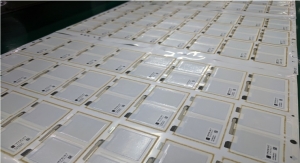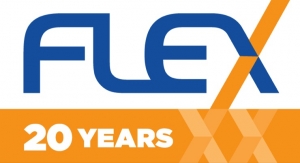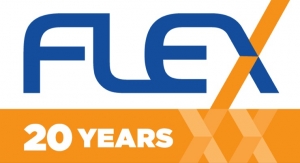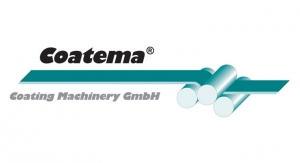David Savastano, Editor09.26.18
Power sources are one of the most critical components for flexible and printed electronics, as these systems often require power to operate. However, coin cell batteries simply aren’t flexible and often are not disposable, thus limiting the product.
Printed flexible batteries can be made in many shapes and sizes. The trick is to provide enough power. With its ZincPoly™ technology and the ability to print its ultrathin flexible batteries on standard commercial printers, including SMT lines, and with plans for very high-volume roll-to-roll presses, Imprint Energy believes it has solved that challenge.
“If you foresee a world with large numbers of inexpensive IoT devices, sensors, tags and wearables that need to communicate, you need a power source that is well-matched to those emerging high-volume applications,” said Steve Weiss, an advisor to Imprint Energy. “Where other companies ‘go big’ on batteries, like for EVs or energy storage, we think there is huge opportunity to ‘go small.’”
Imprint Energy was co-founded in 2010 by its CEO, Christine Ho. The core technology was based on Ho’s doctoral work at UC Berkeley. Weiss noted that the company’s goal was to revamp how batteries are made, to enable four major improvements: size and shape, mass production, printing the battery and keeping it environmentally friendly.
“First, traditionally you designed products around what batteries could do, a problem as batteries grew to over 30% of the volume of modern products,” Weiss said. “Imprint’s technology lets you customize size, shape, capacity, flexibility, etc. Second, she sought to take advantage of ‘available everywhere’ standard commercial printing equipment to ‘mass print’ batteries at low cost, rather than ‘assembling’ batteries, as is done today, and which scales roughly linearly in cost.
“Third, printing the battery meant that makers could print batteries as part of their product, alongside sensors, antennas and chips – further reducing total device costs,” he added. “And fourth, Christine designed an inherently safe, stable and non-toxic solid-state battery, to contrast with many current technologies. That also enabled thinner, more power-dense formats.”
Weiss noted that the company’s ZincPoly™ technology has multiple advantages.
“It’s made from safe, non-lithium-based, stable polymers; that means we print ‘solid-state’ batteries rather than using liquids that need to be sealed,” he said. “That means safe to ship, and safe even if damaged. This same approach reduces internal resistance, enabling the power surges needed to communicate data while using a small battery. It’s rechargeable and disposable, unlike some alternatives.
“Alongside our ZincPoly chemistry, our process technology is designed to print a multi-layer sandwich of our inks and materials, ‘en masse’ in sheets (e.g. on standard SMT lines) or on roll-to-roll high-volume printers. This approach reduces costs, allows direct integration with other printed portions of a device and enables flexibility of the battery,” Weiss added.
“We’ve been marching toward commercialization,” Weiss reported. “That means improvements in underlying chemistry; battery performance; environmental conditions; shelf life; quality; manufacturability; and relentless process improvements and cost reduction. We’re indebted to our many superb partners that have spurred us through their requirements, questions, testing, and feedback.”
While Imprint has developed the technology with only modest investor funding, in part because the company has attracted many projects, partners and grants, the company did just successfully complete a $5 million investment round. The round included Imprint’s technology partner Semtech; the u.life fund, managed by Global Value Investment Portfolio Management (GVIP); and previous investors including Phoenix Venture Partners (PVP).
Weiss reported that Imprint’s batteries are being evaluated and/or tested in a range of products, including medical devices, medical patches, smart tags, cold-chain tracking, and more. Imprint sees an opportunity to license lots of other firms as certified manufacturing partners, either as single components or as an integrated part of a device, rather than trying to produce billions of batteries per year by itself.
For example, Weiss reported that one of Imprint’s batteries is designed to power IoT devices that communicate using Semtech’s LoRa® devices and wireless radio frequency technology (LoRa Technology) for low-power wireless networks, and Semtech and its partners are early customers of Imprint batteries.
“Some applications are beginning to move into field trials rather than in a lab,” he added. “Our initial partners have chosen not to disclose their applications publicly yet, and we respect their confidentiality.”
Weiss said that he expects Imprint Energy to continue its strong growth in the coming years.
“The market need is there,” he observed. “We’re focused on delivering quality products that meet or exceed expectations and building an ecosystem of Imprint-certified manufacturing partners to make our batteries as part of their integrated devices. We expect that in many cases, these will be leading EMS firms and contract manufacturers, which are looking to deliver higher-value design and production services to their customers.”
“Markets and applications have changed considerably in a few short years,” Weiss concluded. “Smart tags that used to cost $20 or $50 are rapidly dropping to $1 or less. Major firms anticipate individual applications that could each consume millions to hundreds of millions of batteries per year: just think of smart pill bottles or smart bandages, for example. Imprint batteries can be an important enabler of these next-gen, high-volume applications.”
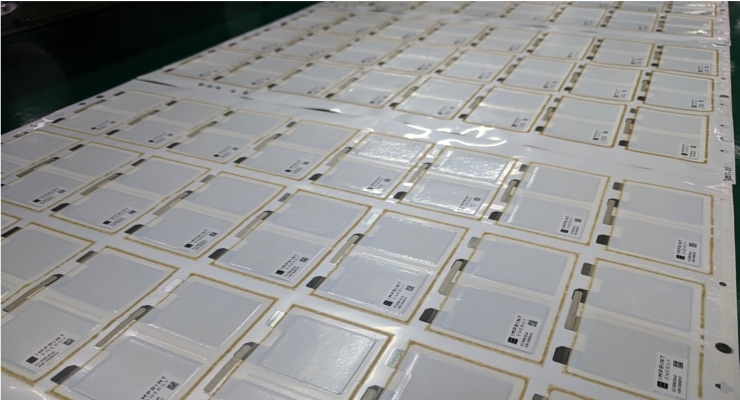
Source: Imprint Energy
Printed flexible batteries can be made in many shapes and sizes. The trick is to provide enough power. With its ZincPoly™ technology and the ability to print its ultrathin flexible batteries on standard commercial printers, including SMT lines, and with plans for very high-volume roll-to-roll presses, Imprint Energy believes it has solved that challenge.
“If you foresee a world with large numbers of inexpensive IoT devices, sensors, tags and wearables that need to communicate, you need a power source that is well-matched to those emerging high-volume applications,” said Steve Weiss, an advisor to Imprint Energy. “Where other companies ‘go big’ on batteries, like for EVs or energy storage, we think there is huge opportunity to ‘go small.’”
Imprint Energy was co-founded in 2010 by its CEO, Christine Ho. The core technology was based on Ho’s doctoral work at UC Berkeley. Weiss noted that the company’s goal was to revamp how batteries are made, to enable four major improvements: size and shape, mass production, printing the battery and keeping it environmentally friendly.
“First, traditionally you designed products around what batteries could do, a problem as batteries grew to over 30% of the volume of modern products,” Weiss said. “Imprint’s technology lets you customize size, shape, capacity, flexibility, etc. Second, she sought to take advantage of ‘available everywhere’ standard commercial printing equipment to ‘mass print’ batteries at low cost, rather than ‘assembling’ batteries, as is done today, and which scales roughly linearly in cost.
“Third, printing the battery meant that makers could print batteries as part of their product, alongside sensors, antennas and chips – further reducing total device costs,” he added. “And fourth, Christine designed an inherently safe, stable and non-toxic solid-state battery, to contrast with many current technologies. That also enabled thinner, more power-dense formats.”
Weiss noted that the company’s ZincPoly™ technology has multiple advantages.
“It’s made from safe, non-lithium-based, stable polymers; that means we print ‘solid-state’ batteries rather than using liquids that need to be sealed,” he said. “That means safe to ship, and safe even if damaged. This same approach reduces internal resistance, enabling the power surges needed to communicate data while using a small battery. It’s rechargeable and disposable, unlike some alternatives.
“Alongside our ZincPoly chemistry, our process technology is designed to print a multi-layer sandwich of our inks and materials, ‘en masse’ in sheets (e.g. on standard SMT lines) or on roll-to-roll high-volume printers. This approach reduces costs, allows direct integration with other printed portions of a device and enables flexibility of the battery,” Weiss added.
“We’ve been marching toward commercialization,” Weiss reported. “That means improvements in underlying chemistry; battery performance; environmental conditions; shelf life; quality; manufacturability; and relentless process improvements and cost reduction. We’re indebted to our many superb partners that have spurred us through their requirements, questions, testing, and feedback.”
While Imprint has developed the technology with only modest investor funding, in part because the company has attracted many projects, partners and grants, the company did just successfully complete a $5 million investment round. The round included Imprint’s technology partner Semtech; the u.life fund, managed by Global Value Investment Portfolio Management (GVIP); and previous investors including Phoenix Venture Partners (PVP).
Weiss reported that Imprint’s batteries are being evaluated and/or tested in a range of products, including medical devices, medical patches, smart tags, cold-chain tracking, and more. Imprint sees an opportunity to license lots of other firms as certified manufacturing partners, either as single components or as an integrated part of a device, rather than trying to produce billions of batteries per year by itself.
For example, Weiss reported that one of Imprint’s batteries is designed to power IoT devices that communicate using Semtech’s LoRa® devices and wireless radio frequency technology (LoRa Technology) for low-power wireless networks, and Semtech and its partners are early customers of Imprint batteries.
“Some applications are beginning to move into field trials rather than in a lab,” he added. “Our initial partners have chosen not to disclose their applications publicly yet, and we respect their confidentiality.”
Weiss said that he expects Imprint Energy to continue its strong growth in the coming years.
“The market need is there,” he observed. “We’re focused on delivering quality products that meet or exceed expectations and building an ecosystem of Imprint-certified manufacturing partners to make our batteries as part of their integrated devices. We expect that in many cases, these will be leading EMS firms and contract manufacturers, which are looking to deliver higher-value design and production services to their customers.”
“Markets and applications have changed considerably in a few short years,” Weiss concluded. “Smart tags that used to cost $20 or $50 are rapidly dropping to $1 or less. Major firms anticipate individual applications that could each consume millions to hundreds of millions of batteries per year: just think of smart pill bottles or smart bandages, for example. Imprint batteries can be an important enabler of these next-gen, high-volume applications.”

Source: Imprint Energy


